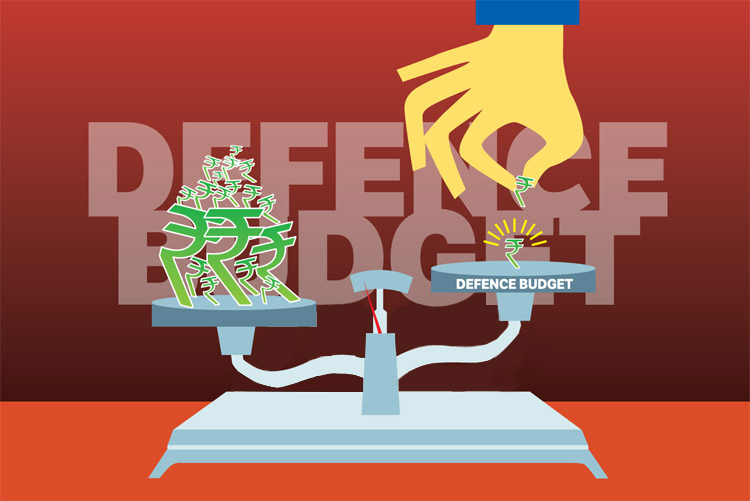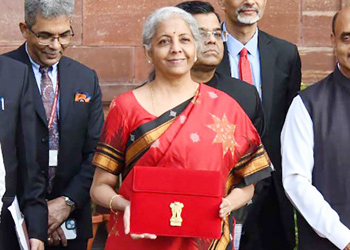INDIAN ARMED FORCES CHIEFS ON
OUR RELENTLESS AND FOCUSED PUBLISHING EFFORTS

SP Guide Publications puts forth a well compiled articulation of issues, pursuits and accomplishments of the Indian Army, over the years

I am confident that SP Guide Publications would continue to inform, inspire and influence.

My compliments to SP Guide Publications for informative and credible reportage on contemporary aerospace issues over the past six decades.
Defence Budget 2024-25
The next defence budget needs to navigate challenges while prioritising modernisation and a shift towards proactive deterrence
 |
The Author is Former Director General of Information Systems and A Special Forces Veteran, Indian Army |

Defence Budget 2024-2025 will be announced in a few weeks from now. The usual process would be underway -the three Services send projections to HQ Integrated Defence Staff (IDS); HQ IDS forwards combined requirement to the Ministry of Defence (MoD); MoD passes on the same to the Finance Ministry and the latter rules only X amount will be made available. Ironically, we don't have a national security strategy to relate the requirements with.
Our defence budget allocations over the past few years have been largely negative in 'actual' terms

Our process is different from the US where the Theatre Commanders and the Commander Special Operations Command present to the Senate Armed Forces Committee their budget demands and how this allocation would enhance their operational capabilities. The Senate Armed Forces Committee then sends the demand to the US Congress for approval.
Our defence budget allocations over the past few years have been largely negative in "actual" terms. This is despite the fact that the Parliament Standing Committee for Defence had gone on record to say that the Defence Budget should be 3 per cent of GDP. There is usual rhetoric of percentage increases which does not take into account the cost escalations.
We have, and also plan,importing weapon platforms and weapons like: Rafales; Rafales and more Scorpene submarines for the Navy; 73,000 SiG Sauer assault rifles from the US; Predator MQ-9B drones from the US and the like. 'Make in India' is fine but self-sufficiency is many decades away. A mix of indigenous and imports is essential to maintain deterrence.
'Make in India' is fine but self-sufficiency is many decades away. A mix of indigenous and imports is essential to maintain deterrence
Equipping the military should not be ad-hoc and, based on political considerations or seeking foreign support to retain power. For example, 36 Rafale fighter jets were contracted for procurement in 2016 against the need for 126 multi-role fighter aircraft (MRFA) established in 2007. The Parliament Standing Committee for Defence has now recommended imports in the MFRA project if the LCA and Kaveri engine development is delayed; in order to address the IAF's fighter shortages.
The media blitz for the expenditure on military pensions was without comparing it with the much higher expense on civil and other government services. A civilian defence employee is four times more expensive than his uniformed counterpart or retiree. Defence Minister Rajnath Singh has publicly stated that the 'Agnipath' scheme has nothing to do with finances.
Equipping the military should not be ad-hoc and, based on political considerations or seeking foreign support to retain power
In formulating the next defence budget, we need to take into account the following:
- The China-Pakistan threat is live and growing both at the asymmetric and conventional levels. Dismissing it would be outrightly foolish. China is building a second highway through Aksai Chin (that would run close to Galwan and Pangong Tso) and another expressway to Nepal for offensive purposes.
- Catching up technologically with China is few decades away. This also includes the matching PLA capabilities in hypersonic, UAVs, electromagnetic and space/near-space based weapons.
- In 2018, the Indian Army went on record to say that 68 per cent of its war fighting equipment is obsolete. Capability to combat swarm drones is an urgent requirement. Today, the FICVs (Future Infantry Combat Vehicles) are needed urgently. Infantry battalions in plains can become cannon fodder without mobility. There was a time when infantry battalions had tracked vehicles called 'Bren Carriers'. Mobility for infantry in plains needs examination.
- Let us not get carried away with the talk of soldiers being replaced by AI and technology. In combating the PLA in high altitude, the soldier on ground will continue to be the deciding factor. In this context, we are losing the advantage of manpower we have over the PLA by employing 3-year employment of Agniveers. The Agnipath scheme needs urgent review. It has numerous disadvantages and does not even save money in the long run.
- According to a recent Pentagon report, about 1,300 of the 1,900 fighter jets of the PLA's Air Force (PLAAF) were 4th generation or more by the end of 2022. The J-20 and FC-31/J-21 are considered 5th generation. In February 2023, Aviation Industry Corporation of China (AVIC) shared its 6th generation fighter concept on social media, which shocked the US.
- In October 2023, the IAF phased out one more squadron of MiG-21, leaving only two MiG-21 squadrons operational. According to the media, the IAF may be down to just 29-30 squadrons – a mix of Su-30 MKI which makes up the largest numbers, Jaguar upgrade, Mirage 2000, MiG-29 and the newly acquired Rafale fighter jets.
- The Chief of Air Staff, Air Chief Marshal V.R. Chaudhari has said it would take another 10 years before the IAF reaches 35 squadrons strength.
- Compared to China, the Indian Navy is way inferior in capabilities, particularly at the sub-surface level. The missing capability of Mine Counter-Measure Vessels (MCMVs) is an invitation to both China and Pakistan to cause serious and avoidable damage to our naval vessels, although today our focus is on drones attacking merchant vessels
It is high time India sheds its defensive outlook and change our way of thinking, change to a pro-active mode and demonstrate this intent, which is the best form of deterrence
As mentioned above, successive annual defence budget allocations have been by and large negative in actual terms. There are the usual announcements that the Armed Forces will never be short of funds, which is nothing more than rhetoric. Take the demand of 1,76,346 crore in 2023-24 for capital acquisitions against which only 1,62,600 crore was allotted, leaving a deficiency of 13,746 crore.
Why is the dearth of funds only for the Armed Forces? One has to be joking to say India is short of finances when a former Chief Minister of Karnataka pocketed 4,00,000 crores, as exposed by an MLA from the same political party on X. Moreover, the organisation of the DRDO needs to be reviewed, as ordered by Prime Minister Narendra Modi, and the flab slashed. Concurrently, there must be much nor investment in defence R&D.
Finally, it is high time India sheds its defensive outlook and efforts to plug capability gaps in ad-hoc fashion. We need to change our way of thinking, change to pro-active mode and demonstrate this intent, which is the best form of deterrence. Hopefully all this will be kept in mind when the defence budget for 2024-2025 is announced, although the Finance Minister Nirmala Sitharaman may not even mention defence in her budget speech, which ironically has become the norm.





